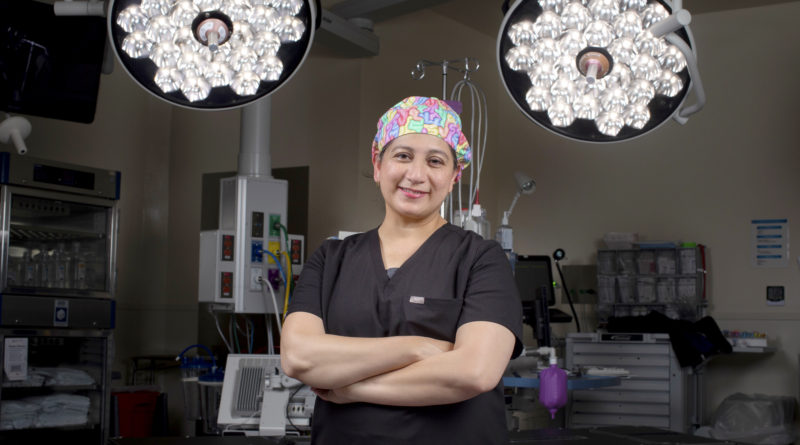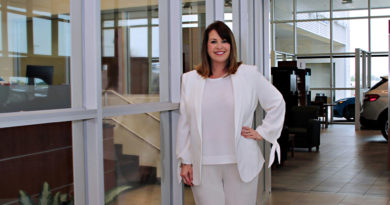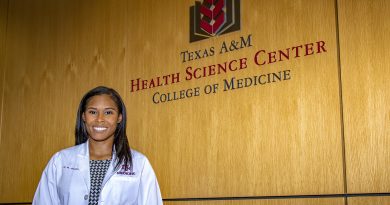Surgical superhero
Dr. Rabia Qaiser wrestles more than complex neurological surgeries at McLane Children’s
By Tonya Warren | Photos by Rusty Schramm of Baylor Scott & White Health
Dr. Rabia Qaiser is a superhero who doesn’t wear a cape or spring from tall buildings. Instead, she wears scrubs, performs surgeries with laser-stealth skill, and walks brightly colored hallways at Baylor Scott & White McLane Children’s Medical Center in Temple as she tends her young patients. Since she was a youngster growing up in Pakistan, Qaiser wanted to be a doctor, and in ninth grade, she set her sights on studying pediatric neurosurgery.
No parent ever wants to hear their child must see a pediatric neurosurgeon. Just the name of such a specialized area of medicine can conjure up terror and tears in the strongest of families. Central Texans are extremely fortunate to have Qaiser’s skills available for children in need of such specialized care. She’s the only pediatric neurosurgeon between Dallas and Austin as well as an extensive east to west radius of the area.
She performs surgeries at McLane Children’s and Baylor Scott & White McLane Children’s Neonatal Intensive Care Unit. According to a 2020 report on pediatric neurosurgery by Loma Linda University, there are only about 300 practicing pediatric neurosurgeons in the United States. Being female, Qaiser is in an elite group.
Thanks to advanced technology, some neurological concerns are discovered before a baby is born, and Qaiser does prenatal consults to help guide parents through such a stressful time. She treats patients from newborns up to age 18 or 21, depending on specific patient needs. A pediatric neurosurgeon treats spina bifida, benign and malignant tumors of the brain and spinal cord, epilepsy, aneurysms, craniosynostosis, vascular malformations, hydrocephalus, traumatic brain and spinal cord injuries, and other conditions requiring neurosurgical intervention.
Qaiser just doesn’t see a patient as someone else in the hospital needing treatment. She respects the inherent dignity of each individual, saying, “I don’t treat a disease or condition. I treat the patient.”
Understandably, families are frightened when they bring their child to see Qaiser. How serious is this condition? Will my child grow up healthy? These are common questions parents have for her to try and answer. She encourages families to be involved in the decision-making process.
“The first thing I do is tell families they are part of the team,” Qaiser said. “I ask them, and the patient, depending on the age, what goals they have. If they want to play basketball or do ballet, we do what we can to make that happen.”
Education is key in helping families face and understand what’s going on with the health of their child.
“Knowledge is power,” Qaiser said. “For instance, if I’m discussing hydrocephalus, I tell the family hydro means water, and cephalus means brain. I’ll bring images up on the computer screen, and as we look at them together, I’ll explain what we’re looking at.”
Kids can be easily frightened in a hospital environment, and it takes someone special to gain confidence and trust from even the smallest of patients. The soft-spoken surgeon has a secret weapon on her cellphone she’ll pull out and show kids to win them over; pictures of her cats doing silly antics such as jumping like a kangaroo or sleeping like a princess — images that easily garner smiles, laughs and light conversation.
“I find whatever I can to connect to the kids,” Qaiser said. “If they want to talk about their favorite superhero, that’s what we do.”
If it takes a village to raise a child, then it certainly takes a bigger village to improve a child’s health, and Qaiser is quick to give praise to staff who work tirelessly with patients and families. She works closely with pediatricians, nurses, child-life specialists, physical and occupational therapists and other team members to help the patient achieve the best results.
She even remembers a patient who had been transferred to Houston for care, and one of the neurology nurses drove down to visit the patient and family.
“I couldn’t do what I do if it weren’t for them,” she said. “I’ve got amazing colleagues and residents.”
As if pediatric neurosurgery isn’t challenging enough, a global pandemic brought its own set of challenges. “I’m very proud of this institution. We provided care through telemedicine, which was a big blessing for our families,” Qaiser said. “Telemedicine was convenient for our families as they didn’t have to arrange sitters for their other children at home.”
Qaiser said the most rewarding aspect of being a doctor is seeing her patients get better. One of things she enjoys is arm wrestling with her patients. “There’s nothing better than losing arm wrestling with a patient,” she said, laughing.
The most challenging aspect of her profession is when a child has limited treatment options.
“You offer companionship and love. Medicine teaches us to be humble,” Qaiser said.




